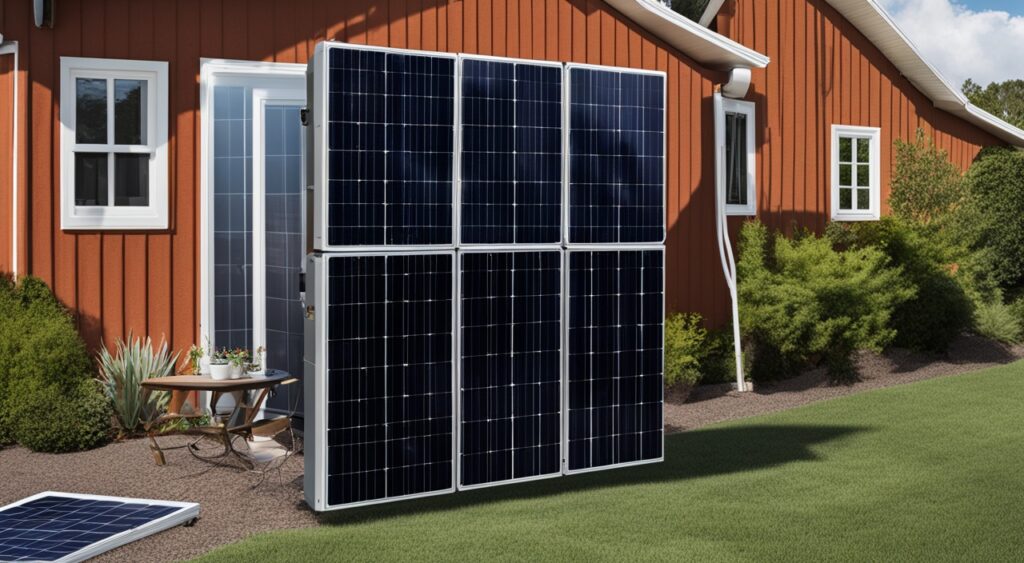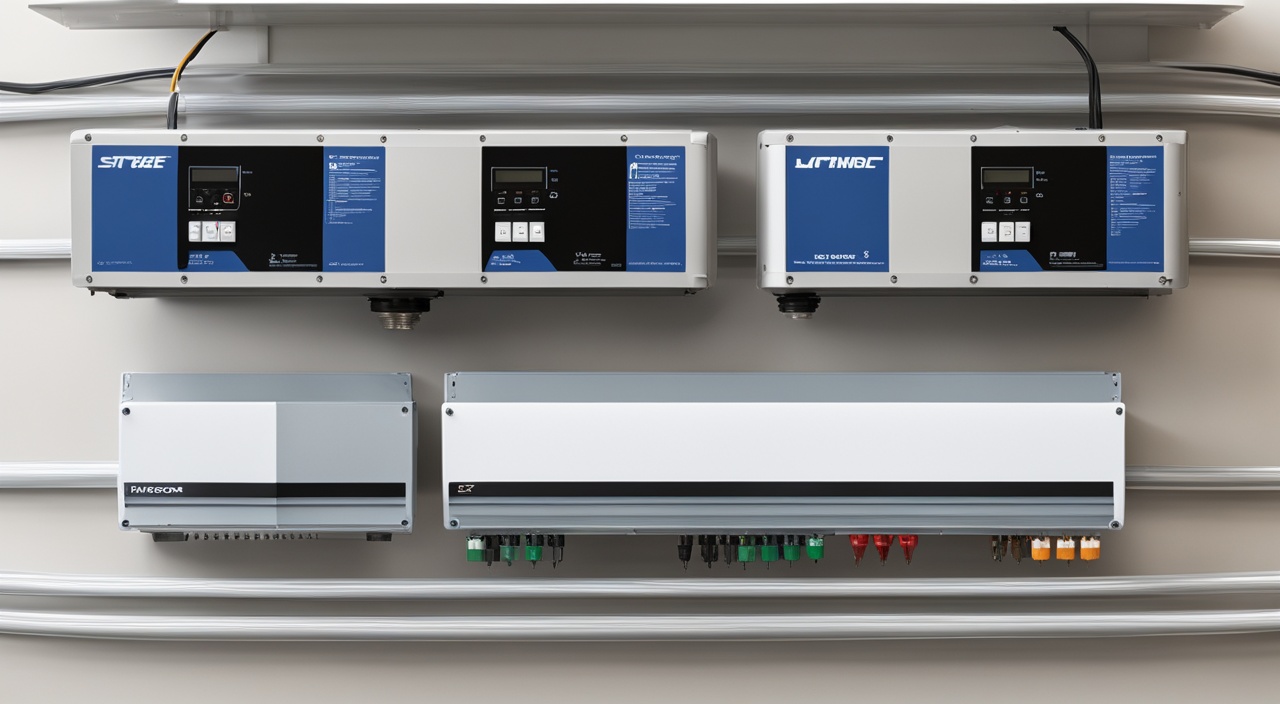String Inverters vs. Micro Inverters: Pros and Cons
Choosing between string inverters and micro inverters is key for your solar energy system’s performance and cost. We’ll look at the pros and cons of each inverter type. This will help you pick the best option for your solar energy needs.
We’ll cover important factors like cost, efficiency, monitoring, scalability, and warranty. By the end, you’ll know which inverter type fits your solar energy goals best. This is true whether you’re a homeowner or managing a commercial property.
Key Takeaways
- String inverters and micro inverters are two distinct solar inverter technologies with unique advantages and disadvantages.
- Cost considerations include initial installation expenses and long-term maintenance and replacement costs.
- Solar panel efficiency and performance can be impacted by factors such as shading, which affects the choice between string and micro inverters.
- System monitoring and troubleshooting capabilities vary between the two inverter types, impacting ease of maintenance.
- Scalability and future expansion options are important factors to consider when selecting an inverter system.
Introduction to Solar Inverter Technologies
Solar inverters are key in changing direct current (DC) from solar panels into alternating current (AC). This AC is what homes and businesses use. It’s important to know about the solar inverter technologies out there. This knowledge helps in picking the right system for your solar energy needs.
Overview of String Inverters and Micro Inverters
Solar inverters come in two main types: string inverters and micro inverters. String inverters are big units that take DC from many solar panels and turn it into AC. Micro inverters are smaller and go on each solar panel. They change DC to AC right there on the panel.
Importance of Choosing the Right Inverter System
Picking the right inverter system is key for your solar energy system’s efficiency and performance. You should think about the size of your system, how much shade it gets, and if you might need to grow it later. Deciding between string inverters and micro inverters affects your costs, energy output, and how well your solar setup will work in the long run.
“Choosing the right solar inverter technology is a critical decision that can make or break the performance and cost-effectiveness of your solar energy system.”
Next, we’ll look into the good and bad of string inverters and micro inverters. We’ll also help you pick the best inverter for your needs.
Pros and Cons of String Inverters vs. Micro Inverters
String inverters and micro inverters each have their own strengths and weaknesses. Knowing these differences helps you choose the right inverter for your solar setup.
Pros of String Inverters
- Generally more cost-effective for larger solar systems
- Require less overall installation and maintenance effort
- Provide centralized monitoring and control of the entire solar array
Cons of String Inverters
- A single point of failure can impact the performance of the entire solar system
- Less efficient in partially shaded conditions, as the output is limited by the weakest panel
- Reduced system flexibility, as adding or replacing panels is more complicated
Pros of Micro Inverters
- Optimize the output of each individual solar panel, improving overall system efficiency
- Continued operation even in the event of a single panel or micro inverter failure
- Easier expansion and scalability of the solar system
Cons of Micro Inverters
- Generally more expensive upfront cost
- Require more individual components, which can increase installation complexity
- Distributed monitoring and control system, which may be less convenient for larger installations
The choice between string and micro inverters depends on your solar setup, budget, and goals. It’s key to consider the pros and cons of each to find the best match for your needs.

Cost Considerations for String and Micro Inverter Systems
Choosing between string and micro inverters means looking at upfront costs and long-term expenses. These costs include installation, maintenance, and replacement. Let’s explore the financial aspects of these solar inverter types.
Initial Installation Costs
String inverters are usually cheaper to install than micro inverters. They need fewer parts and are simpler to set up. Micro inverters cost more upfront because each solar panel gets its own unit.
Long-Term Maintenance and Replacement Costs
Over time, the cost of maintaining and replacing an inverter can add up. String inverters don’t last as long, needing replacement every 10-15 years. Micro inverters can last 15-25 years, saving on replacement costs.
Micro inverters also make replacing parts easier. You can swap out a single unit instead of the whole system. This cuts down on maintenance costs over time.
“The upfront cost and long-term maintenance requirements of an inverter system are crucial factors to consider when choosing between string inverters and micro inverters.”
Deciding between string and micro inverters depends on your needs, budget, and goals. Look at the initial costs and future maintenance and replacement costs. This will help you make a choice that fits your solar energy plan.
Solar Panel Efficiency and Performance
Getting the most out of solar energy means focusing on your system’s efficiency and performance. The choice between string inverters and micro inverters is crucial. It affects how your solar panels work in different conditions, like when there’s shade. This choice can change how much power your system makes.
Impact of Shading on System Output
String inverters and micro inverters handle shading differently. String inverters treat all solar panels as one unit. So, if one panel is shaded, the whole system’s performance drops. Micro inverters, however, work on each panel separately. This way, shading affects only the shaded panel, not the whole system.
| Factors | String Inverters | Micro Inverters |
|---|---|---|
| Shading Effects | Significant impact on system output | Minimal impact on individual panel performance |
| System Efficiency | Can be lower due to shading effects | Typically higher due to panel-level optimization |
| Monitoring Capabilities | Monitor system-level performance | Monitor individual panel performance |
Knowing how string inverters and micro inverters deal with shade helps you choose the best for your solar setup. This ensures your solar panel efficiency and system performance are top-notch.
System Monitoring and Troubleshooting
Effective system monitoring and maintenance are key for solar energy systems. We’ll look at how string inverters and micro inverters differ in these areas. This will help you choose the right one for your needs.
Monitoring Capabilities and Ease of Maintenance
String inverters let you monitor your solar system’s overall performance from one spot. This is handy but might hide problems with individual panels. Micro inverters, however, show how each panel is doing. This makes finding and fixing issues easier.
String inverters need less upkeep than micro inverters. They’re often in a spot that’s easy to get to, making them simpler to fix or replace. Micro inverters, being on each panel, require more effort to maintain and swap out.
| Feature | String Inverters | Micro Inverters |
|---|---|---|
| Monitoring Capabilities | Centralized monitoring of overall system performance | Individual module-level monitoring for more detailed insights |
| Maintenance Requirements | Generally less hands-on attention required | More time-consuming maintenance due to their distributed nature |
Choosing between string and micro inverters depends on what you need. Knowing how each affects system monitoring, troubleshooting, and maintenance requirements will help you decide. This way, you can pick the best option for your setup.
Scalability and Future Expansion Options
As your energy needs change, it’s key to pick a solar system that can grow with you. When deciding between string inverters and micro inverters, think about how each can help you expand in the future. This choice greatly affects your solar investment’s future.
String inverters are great for scalability. They let you add more solar panels as your energy use increases. This is perfect for homeowners or businesses that expect to grow. Just connect more panels to your existing string inverter to boost your solar power.
Micro inverters, however, offer a flexible way to expand. Each solar panel has its own micro inverter. This means you can add or remove panels easily without affecting others. It’s great if you want to slowly increase your solar setup or if your energy needs change.
When picking between string and micro inverters, think about your future energy goals. Consider how your energy needs might change. By choosing the right inverter technology, your solar setup can grow and change with you.
Warranty Coverage and Manufacturer Support
When you choose solar energy, the warranty and support from the maker are key to your system’s success. It’s important to know how string inverters and micro inverters differ in these areas. This knowledge helps you make a smart choice.
Comparing Warranty Policies and Support Services
String inverters usually come with longer warranties, lasting from 10 to 25 years. Micro inverters have shorter warranties, around 10 to 15 years. But, micro inverter makers might offer better coverage, like against power loss and natural disasters.
Both string and micro inverter companies aim to offer great support. They provide online tools for checking your system, fixing problems, and getting help. Some even have local experts ready to visit you quickly.
| Feature | String Inverters | Micro Inverters |
|---|---|---|
| Warranty Period | 10-25 years | 10-15 years |
| Warranty Coverage | Power output, component failures | Power output, component failures, natural disasters |
| Manufacturer Support | Online tools, local service providers | Online tools, local service providers |
Looking at the warranties and support from various inverter makers helps you choose wisely. This ensures your solar system works well for a long time.
Residential vs. Commercial Applications
Choosing between string inverters and micro inverters depends on the application – whether it’s for homes or businesses. Each setting has its own needs. It’s important to know these needs to pick the right inverter technology.
Suitability for Residential and Commercial Solar Installations
Residential applications often favor micro inverters. They work well with smaller rooftops and perform better in shady spots. Homeowners like the system’s flexibility and can easily spot and fix problems. For commercial applications, string inverters might be better. They’re more cost-effective for big solar setups.
When picking between string inverters and micro inverters, think about the system size, energy needs, and how it will be installed. This helps users make a choice that meets their project goals. It also ensures their solar system works efficiently and performs well over time.
“The choice between string inverters and micro inverters is not a one-size-fits-all decision. It’s crucial to carefully consider the unique requirements of your residential or commercial solar installation to ensure the most suitable inverter technology is selected.”
Emerging Trends and Future Developments
The solar industry is always changing, bringing new advancements in inverter technology. These changes might affect your choice between string and micro inverters. We’ll see better efficiency and monitoring features that will change how we use renewable energy at home and work.
Potential Advancements in Inverter Technology
Smart inverters are a big deal for the future. They make energy production better, check how well systems work, and talk to the grid for important data. As we use more renewable energy, smart inverters will help keep the power stable and reliable.
Hybrid inverters are also on the rise. They can handle different energy sources like solar panels, batteries, and wind turbines. This means people and businesses can have energy systems that are strong and can adjust to power outages and changing energy needs.
Micro inverters are getting better too. They’re becoming more efficient, smaller, and cheaper. As they improve, micro inverter systems might be a top choice for small solar setups. They offer more flexibility and make each solar panel work better.
The future of solar inverters is thrilling, with new tech that lets us use the sun’s power better and more efficiently than ever.
“The future of solar energy lies in the continuous improvement and innovation of inverter technology, which will be essential in driving the widespread adoption of renewable power sources.”
Choosing the Right Inverter for Your Solar System
Choosing the right inverter for your solar system is crucial. It affects your system’s performance, efficiency, and cost. When deciding between string and micro inverters, consider several key factors. This will help you pick the best option for your solar project.
Factors to Consider When Selecting an Inverter
When picking between string and micro inverters, think about your solar system’s needs. Key factors to consider include:
- System Size and Configuration – Know your solar array’s size and layout to choose the right inverter type and capacity.
- Shading Conditions – Check how much shading your solar panels will face. This affects inverter performance.
- Budget and Cost Considerations – Look at the upfront costs and future maintenance and replacement costs of each inverter.
- Monitoring and Troubleshooting – Think about how easy it is to monitor and fix the inverter for optimal performance.
- Scalability and Future Expansion – Consider if the inverter can grow with your solar panel additions or upgrades.
- Manufacturer Warranty and Support – Check the warranty and support services for each inverter type.
By looking at these factors, you can choose the right inverter for your solar project. This ensures your renewable energy investment does well in the long run.
“Selecting the right inverter technology is a critical step in designing a high-performance, cost-effective solar energy system.”
Conclusion
Choosing between string inverters and micro inverters for solar energy is a big decision. We need to look at the pros and cons of each. This includes cost, efficiency, performance, and how well they fit our solar needs.
String inverters are cheaper, especially for big solar setups. But, they might have problems with shading or panel failure. Micro inverters are more flexible and let us watch each panel closely. They cost more upfront.
The choice between string and micro inverters depends on our solar needs, budget, and goals. By looking at the trade-offs and new inverter tech, we can pick the best option. This way, we make sure our solar system works well and lasts a long time.

